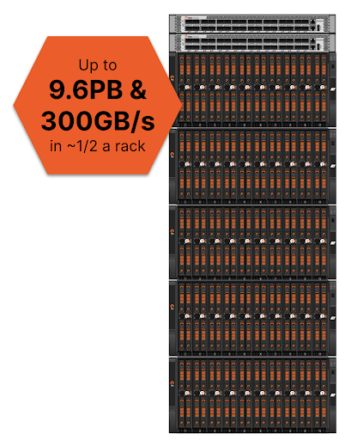Unstructured data storage has evolved dramatically, from being about simple storage and retrieval of user data to now much more complicated workflows involving complex, machine-generated data of varying complexity.
But in today’s chaotic and rapidly changing landscape, a storage array should be simple to use, even when performing the most complex of operations with minimal user intervention. This could be configuration, optimization, or troubleshooting—but the end result is time spent on fixing infrastructure that could be spent elsewhere. And a major source of friction in highly complex, modern applications is performance.
As businesses bring in ever-increasing amounts of data that necessitates a constantly growing storage infrastructure, this creates increased pressure on already strained data center space and power budgets.
Pure Storage® FlashBlade//S™ breaks from the status quo by delivering sustainable, highly dense storage systems that drastically reduce your total cost of ownership and operation for unstructured data workloads.
FlashBlade//S helps to solve real customer problems at scale, and no better example of this is how FlashBlade scales using our multi-chassis scaling architecture. FlashBlade//S offers:
- Phenomenal performance: In a FlashBlade//S system, every blade addition increases performance, even as it scales out to multiple chassis. This performance boost scales linearly with the number of blades in a multi-chassis system, irrespective of the data type, protocol, or load on the system. This is ideal for modern, scalable applications which will see increased performance, transparently.

- Unparalleled density: Each blade in FlashBlade//S can house up to four 24 or 48 terabyte DirectFlash® Modules (DFMs) which increase system capacity. Pure Storage’s DirectFlash technology—unique in the industry—satisfies the massive capacity and performance requirements of today’s enterprise workloads. Pure Storage has a consistent track record of exceeding customer expectations by delivering denser storage devices every year. Combined with FlashBlade//S multi-chassis scaling, imagine how large systems will be in the future.
- Simplicity at scale: Common between FlashBlade//S multi-chassis and single chassis systems is simplicity. The user experience remains the same and all workflows leveraging NFS, SMB, and S3 protocols are seamless even while storing and managing petabytes of data.
- Supreme resiliency: Purity//FB is the storage operating system for FlashBlade//S and provides storage resiliency to tolerate simultaneous component failures in any system configuration. FlashBlade//S frees administrators from having to manage complex resiliency structures and trade-offs by automatically managing resiliency system-wide.
- Efficient TCO:
- CAPEX: FlashBlade//S doesn’t just optimize resiliency but also how the data can be structured to provide maximum space efficiency and minimize overhead on the system. Simply put, you can lower CAPEX as you can store more data and lower your incurred cost per terabyte.
- OPEX: Taking the same notion one step forward, if you’re able to store data that would normally use two storage systems, in a single system, that helps you reduce the data center expenses to maintain those extra storage systems. Hence, you can reduce your OPEX.
- Security and compliance: FlashBlade//S multi-chassis systems follow industry-standard security practices, providing always-on encrypted data at rest (D@RE) storage across all supported storage protocols with no performance impact, as well as optional encryption of data in-flight. For example, FlashBlade//S uses TLS 1.2 which is enabled by default.
Over the years, Pure Storage has had one goal in mind: to design systems that solve customer problems while providing industry-leading simplicity and performance. With FlashBlade//S multi-chassis systems, users can easily scale modern applications and workloads and store more data with added resiliency, all with the same simplicity as a single chassis FlashBlade//S system.

BUYER’S GUIDE, 14 PAGES
Reevaluating Your Virtualization Strategy?
Explore your options in our guide to modern virtualization.
Simplicity at Scale
Ready to solve your unstructured data challenges?







